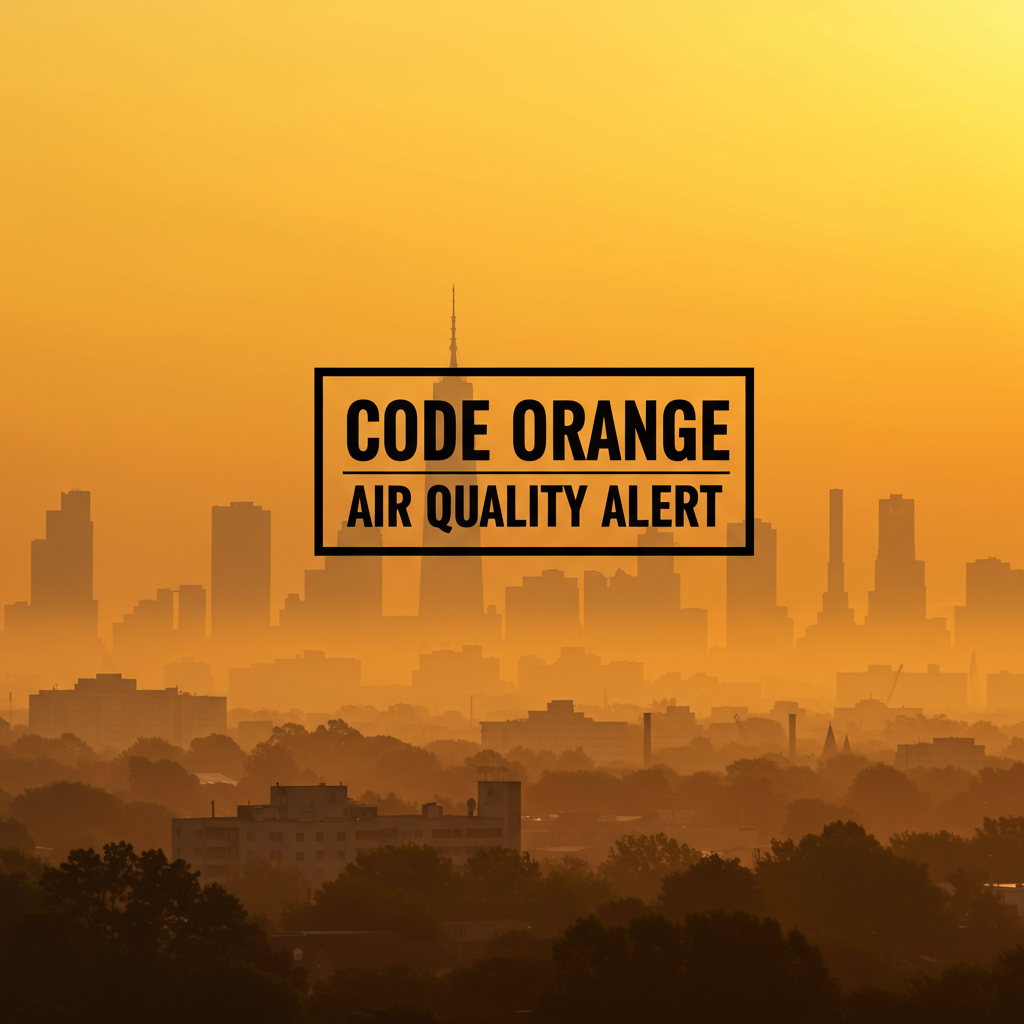Experiencing hazy skies or noticing a change in the air you breathe? An air quality alert, specifically a Code orange, has been issued for Saturday in various regions, signaling conditions that can affect public health. Understanding what this alert means, who is most vulnerable, and what steps you can take is crucial for staying safe and potentially helping improve air quality. This guide breaks down the Code Orange alert, explaining the risks and providing actionable advice based on recent advisories across the country.
Understanding Air Quality Alerts: What is Code Orange?
Air quality forecasts use a simple color-coded system to communicate pollution levels and potential health effects. This system, often managed by agencies like the EPA in partnership with state and local environmental departments, helps the public quickly understand daily air conditions. A Code Orange alert signifies that air quality is projected to be “unhealthy for sensitive groups.” This means certain individuals may experience health effects from air pollution, while the general public is less likely to be affected, though prolonged exposure could still pose risks. It falls between Code Yellow (Moderate air quality, generally acceptable) and Code Red (Unhealthy for everyone).
The Color Code System
The Air Quality Index (AQI) uses colors to denote different levels:
Green: Good (0-50) – Air quality is satisfactory.
Yellow: Moderate (51-100) – Air quality is acceptable; however, some pollutants may pose a moderate health concern for a very small number of people who are unusually sensitive to air pollution.
Orange: Unhealthy for Sensitive Groups (101-150) – Members of sensitive groups may experience health effects. The general public is less likely to be affected.
Red: Unhealthy (151-200) – Everyone may begin to experience health effects; members of sensitive groups may experience more serious health effects.
Purple: Very Unhealthy (201-300) – Health warnings of emergency conditions. The entire population is more likely to be affected.
Maroon: Hazardous (301-500) – Health alert: everyone may experience more serious health effects.
A Code Orange alert specifically warns about potential health issues for vulnerable populations. It requires individuals in these groups to take precautions.
Who is Affected by a Code Orange Alert? Identifying Sensitive Groups
The term “sensitive groups” refers to populations more susceptible to the effects of air pollution. During a Code Orange alert, these individuals face a higher risk of experiencing adverse health symptoms.
Sensitive groups typically include:
Young children
Older adults
People with respiratory conditions (such as asthma, bronchitis, emphysema, or COPD)
Individuals with heart disease
People who engage in extended or heavy exertion outdoors
If you fall into one of these categories, or care for someone who does, paying close attention to Code Orange advisories is especially important. Even seemingly mild pollution levels can trigger symptoms in these vulnerable individuals.
Why Are Code Orange Alerts Issued? Common Causes
Code Orange alerts are triggered when concentrations of specific air pollutants are expected to reach levels harmful to sensitive groups. The primary pollutants leading to these alerts often include ground-level ozone and fine particulate matter (PM2.5). The cause can vary depending on location and weather patterns.
Ground-Level Ozone
One common culprit, particularly during warmer months, is ground-level ozone. Unlike the protective ozone layer high in the atmosphere, ground-level ozone is a harmful pollutant. It forms when pollutants emitted by cars, power plants, industrial boilers, refineries, chemical plants, and other sources react chemically in the presence of sunlight. Hot, sunny days with light winds can trap these pollutants, leading to elevated ozone levels. This phenomenon occurs a few times each summer, often in urban and populous areas with higher traffic and industrial activity. Recent Code Orange alerts in Northeast Ohio, for example, were specifically attributed to elevated ground-level ozone.
Fine Particulate Matter (PM2.5)
Another significant cause of Code Orange alerts is high levels of fine particulate matter, known as PM2.5. These are tiny particles, smaller than the width of a human hair, that can penetrate deep into the lungs. PM2.5 pollution is often linked to sources like smoke from wildfires, industrial processes, and vehicle exhaust. Smoke from wildfires, whether local or hundreds of miles away (like Canadian smoke reaching the Philadelphia region or New Jersey smoke affecting the DC area), is a frequent trigger for particulate matter alerts, including Code Orange and sometimes even Code Red if concentrations are high enough. These particles can irritate airways and worsen existing lung or heart conditions.
Weather plays a critical role in air quality. Sunny conditions exacerbate ozone formation, while stagnant air or temperature inversions can trap pollutants near the ground. Rain showers, on the other hand, can help wash pollutants out of the air, potentially improving conditions.
Health Risks and Symptoms During Code Orange Conditions
Exposure to Code Orange level air pollution can lead to various health symptoms, especially for sensitive groups. The specific symptoms may depend on the primary pollutant (ozone or PM2.5) and individual health status.
Ozone Exposure Risks
Breathing air with elevated ozone levels can cause:
Coughing
Throat irritation
Pain, burning, or discomfort in the chest when taking a deep breath
Chest tightness, wheezing, or shortness of breath
Ozone can aggravate asthma and other respiratory conditions, making breathing more difficult. It can also reduce lung function and inflame the linings of the lungs.
PM2.5 Exposure Risks
Exposure to fine particulate matter can cause:
Increased coughing or difficulty breathing
Aggravated asthma
Development or worsening of bronchitis
Because these particles are so small, they can travel deep into the respiratory system. Prolonged exposure has been linked to more serious health problems, including increased risk of heart attack and stroke over time.
Sensitive individuals might notice symptoms sooner or experience more severe reactions than the general public. It’s essential for these groups to monitor their symptoms and take appropriate precautions during a Code Orange alert.
Protecting Yourself: Actions to Take During a Code Orange Alert
When a Code Orange air quality alert is issued, particularly for Saturday or any other day, sensitive groups should take proactive steps to minimize exposure and protect their health.
Key actions for sensitive individuals include:
Limit Outdoor Activity: Reduce the amount of time spent outdoors, especially during the afternoon and early evening when pollutant levels often peak.
Monitor Outdoor Exertion: If you must be outdoors, avoid strenuous activities like intense exercise or heavy physical labor. Opt for less intense activities or shorten your time outside.
Stay Indoors: Remain in indoor environments with filtered air if possible.
Listen to Your Body: Pay attention to any symptoms like coughing, shortness of breath, or chest discomfort. If you experience these, move indoors and reduce activity.
While the general public is typically less affected, it’s still wise for everyone to be aware of the alert. If you notice symptoms or are unusually sensitive to air pollution, following the advice for sensitive groups is recommended. Checking the latest air quality data on platforms like AirNow.gov can provide real-time information for your specific location.
How Everyone Can Help Improve Air Quality
Addressing air quality issues is a community effort. While Code Orange alerts signal potentially unhealthy air, everyone can take steps to help reduce pollution levels, both during alerts and throughout the year. Simple changes in daily habits can make a collective impact.
Actions recommended by environmental agencies often include:
Drive Less: Opt for public transportation, carpool with others, bike, walk, or work from home when possible. Combining multiple errands into a single trip also reduces driving time and emissions.
Maintain Vehicles: Ensure your car is properly tuned to reduce emissions.
Avoid Idling: Turn off your engine when parked rather than letting it idle unnecessarily.
Refuel Smart: Refuel your vehicle after sunset. Gasoline vapors contribute to ozone formation, and waiting until cooler evening hours reduces this reaction. Avoid spilling gas and make sure your gas cap is tightly sealed.
Delay Mowing: Wait until evening or delay mowing your lawn until air quality improves, as lawnmower emissions can contribute to pollution.
Avoid Burning: Refrain from burning yard waste or other materials. In many areas, open burning is prohibited on Air Quality Action Days coded Orange or higher.
By adopting these practices, individuals can help decrease the pollutants that contribute to ground-level ozone and particulate matter, potentially reducing the frequency and severity of future air quality alerts.
Checking Local Air Quality Information
Knowing the current air quality in your specific area is crucial during an alert. Several resources provide up-to-date information. The AirNow website (www.airnow.gov) is a primary national resource, offering real-time AQI data by zip code. Many state environmental protection departments and local news outlets also provide regional air quality forecasts and alert notifications. These resources often issue forecasts for the current day and the following day, sometimes including hourly updates, allowing you to plan outdoor activities accordingly.
Frequently Asked Questions
What does “Code Orange air quality” mean and who is considered a sensitive group?
A Code Orange air quality alert indicates that air pollution levels are expected to be “unhealthy for sensitive groups.” This means people who are more vulnerable to pollution may experience health effects. Sensitive groups typically include children, older adults, and individuals with pre-existing health conditions, especially those with respiratory issues like asthma or heart disease.
Where can I get the latest air quality information for my specific area?
You can find the most current air quality data and forecasts for your location by visiting the AirNow website at www.airnow.gov. This site provides real-time Air Quality Index (AQI) values. Many state environmental protection agencies and local news weather reports also publish regional air quality updates and alert notifications.
What specific actions should sensitive individuals and the general public take during a Code Orange alert?
Sensitive individuals should limit their time outdoors, especially during peak pollution hours (often afternoon/evening), and avoid strenuous outdoor activity. Everyone can help improve air quality by driving less (carpooling, public transit, combining trips), avoiding vehicle idling, refueling cars after sunset, and delaying lawn mowing or burning until conditions improve.
Conclusion
A Code Orange air quality alert serves as an important reminder that the air we breathe can pose health risks, particularly for vulnerable populations. Understanding the meaning behind the alert, recognizing the potential health impacts, and knowing the recommended actions are vital steps toward protecting yourself and your loved ones. Whether the cause is ground-level ozone on a hot day or distant wildfire smoke, staying informed through resources like AirNow.gov and taking simple precautions can make a significant difference during these periods. By collectively adopting habits that reduce pollution, we contribute to healthier air for our communities, today and in the future. Stay vigilant, check local advisories, and prioritize your health when air quality is compromised.


